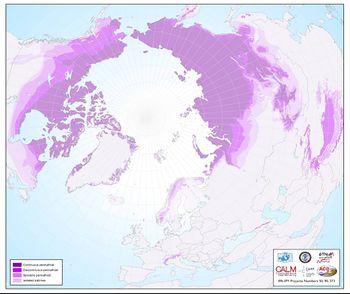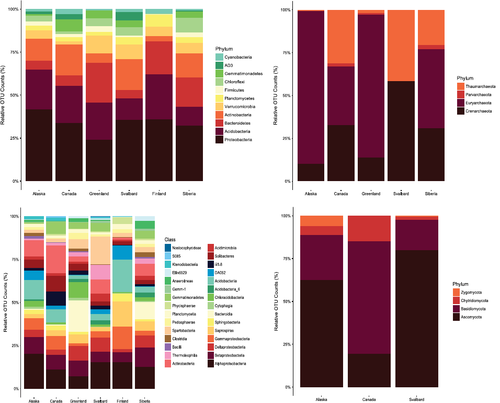Arctic Soils
Overview
By Tia Chung-Swanson
Arctic soils contain a large reservoir of stored carbon in the form of permafrost. When permafrost thaws, soil microbes activate and contribute heavily to biogeochemical nutrient cycling. This may have severe implications for Arctic microbial communities and the future of climate change.
Detailed Environmental Description

In the first soil classification system, created in the 1890s, there were five natural soil zones: tundra, podzol, chernozem, desert, and laterite.[1] Arctic soils were classified in this system as tundra soils. Even with the limited knowledge from the 19th century, it was clear that cold-climate zones were unique because of the much more relevant layer of permafrost. Permafrost is soil that remains permanently frozen for the entire year, which is topped by an active layer that thaws each summer and then freezes again for the winter.[2] Today, arctic soils are classified as gelisols within the soil taxonomy created by the Natural Resources Conservation Service. A gelisol is defined as a soil that has either “permafrost within 100 cm of the soil surface,” or “gelic materials within 100 cm of the soil surface and permafrost within 200 cm of the soil surface.”[3] Since permafrost is frozen year-round, it stores a large amount of organic matter that does not get degraded. Arctic soils are particularly interesting at the moment due to anthropogenic climate change. When permafrost melts from the rising temperatures, the microbes stored in that soil activate and they can use all the newly accessible nutrients. They release CO2[4] and possibly other greenhouse gases, like CH4, and N2O.[5] This permanently increases the thickness of the active layer, which has implications for the biogeochemical cycling that the Arctic and other gelisols are capable of.
Overview of Microbial Ecology as it is known

Arctic soils are dominated by Proteobacteria and Acidobacteria. The next most common phyla are Bacteriodetes and Actinobacteria, but the proportion of these two varies by study site.[6] The proportion of cyanobacteria is very low compared to other nutrient-rich soils like molisols due to the much thinner active layer of Arctic soils.
The archaeal phyla are much less consistent. Most phyla are represented, but in different proportions across study sites, though there are consistently very few members from the Parvarchaeota phylum compared to the other phyla. Fungal phyla are dominated by Ascomycota and Basidiomycota. [6]
Contributions to Climate Change
Anthropogenic climate change is ongoing, and it causes temperatures to rise, particularly at high latitudes. This warming contributes to permafrost thaw, which creates a positive feedback loop that releases more greenhouse gases and spurs further climate change.[7] This has been happening for a relatively short time scale, so it is not completely certain how this will affect microbes in the affected areas. However, some experiments have found that soil microbes do not acclimate to the warming trend and continue to accelerate climate change.[8] Microbial communities in Arctic soil also may be permanently altered by the warming trend.[9]
Carbon
Permafrost thaw exposes organic carbon that has not been broken down previously, because the cold temperatures have preserved it. The thaw allows previously inactive microbes to use it for respiration and create CO2. When the CO2 is produced, it enters the atmosphere and becomes part of the active carbon cycle rather than being stored in the permafrost reservoir. Atmospheric carbon contributes to the greenhouse effect, which keeps Earth warm by storing the heat from the sun, like a greenhouse. This is generally a helpful effect that keeps life possible, but the increased carbon dioxide in the atmosphere due to human contributions has caused the mean global temperature to rise over time. The heat then contributes to more permafrost thaw, leading to more CO2 release, creating a positive feedback loop that could heat Earth until it reaches dangerous levels. There is no way to re-freeze permafrost besides a total Earth temperature decrease, so we must decrease our carbon emissions and work on degrading the greenhouse gases that we've already released.
Nitrogen
Nitrogen fixation is the process in which nitrogen gas (N2) is converted into biologically useful forms of nitrogen, like ammonia (NH3). Eukaryotes are unable to do this for the most part, so they depend on bacteria and some archaea to create useful nitrogen for them. Some nitrogen fixers create ammonia, which does not have a very long residence time in the atmosphere, but others create N2O, which has a similar contribution to the greenhouse effect as CO2 at first. However, after about 120 years, N2O moves up to the troposphere, where it eventually leads to the destruction of stratospheric ozone.[10]
Key Microbial Players
Nitrogen fixing Proteobacteria, including Rhizobiales, Burkholderiales, Xanthomonadales, and Myxococcales dominate and do all of the nitrogen fixing in Arctic soils. These orders belong to Alphaproteobacteria, Betaproteobacteria, Gammaproteobacteria, and Deltaproteobacteria respectively. Despite the low percentage of Cyanobacteria in these soils, Cyanobacteria are still critically important because they are responsible for most of the CO2 and N2 uptake.[6] Nitrogen fixers are so important that one study found that Arctic microbial communities are actually N-limited, rather than C-limited like most other soil microbial communities.[5]
Conclusion
Arctic soils are diverse in terms of microbial life, despite their extreme climatic conditions. As the active layer gets thicker, additional microbial activity contributes to greenhouse gases that add to further warming in a positive feedback loop. More work is needed in the study of Arctic soils to determine how to slow this warming effect and prevent more harm to our planet.
References
- ↑ Tedrow and Cantlon: Concepts of Soil Formation and Classification in Arctic Regions. Arctic 1953 11:03.
- ↑ International Permafrost Association: What is Permafrost? 2015.
- ↑ Soil Taxonomy: A Basic System of Soil Classification for Making and Interpreting Soil Surveys. Agriculture Handbook 1999 436.
- ↑ Waelbroeck et al.: The impact of permafrost thawing on the carbon dynamics of tundra. Geophysical Research Letters 1997 24:03.
- ↑ 5.0 5.1 Nordin et al.: Nitrogen Uptake by Arctic Soil Microbes and Plants in Relation to Soil Nitrogen Supply. Ecology 2004 85:04.
- ↑ 6.0 6.1 6.2 Malard and Pearce: Microbial diversity and biogeography in Arctic soils. Environmental Microbiology Reports 2018 10:06.
- ↑ Cox et al.: Acceleration of global warming due to carbon-cycle feedbacks in a coupled climate model. Nature 2000 408.
- ↑ Hartley et al.: Soil microbial respiration in Arctic soil does not acclimate to temperature. Ecology Letters 2008 11:10.
- ↑ Deslippe et al.: Long-term warming alters the composition of Arctic soil microbial communities. FEMS Microbiology Ecology 2012 82:02.
- ↑ Myron B. Thompson Academy: Climate and Water Resource Case Study. 2006.
Authored for Earth 373 Microbial Ecology, taught by Magdalena Osburn, 2020, NU Earth Page.
